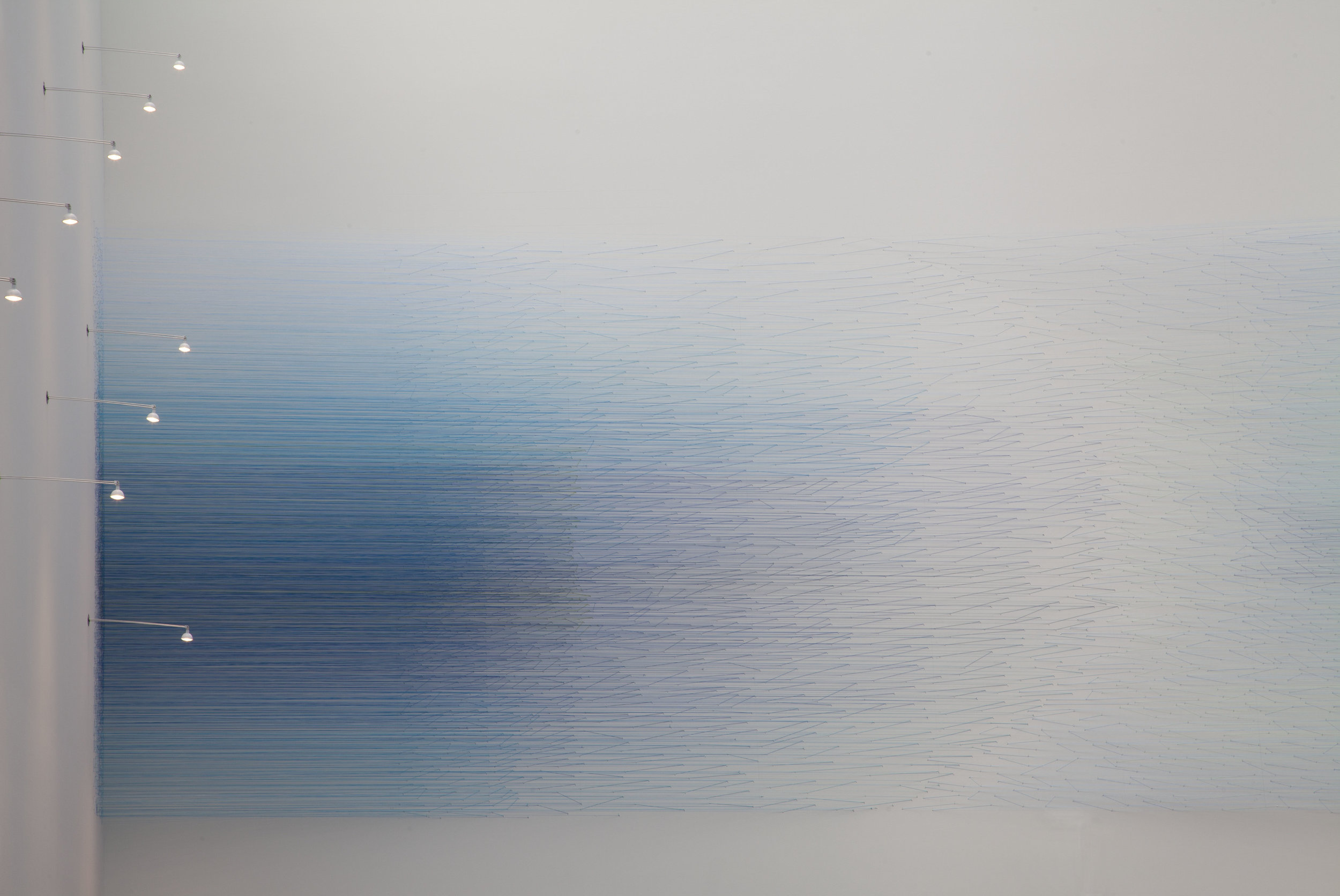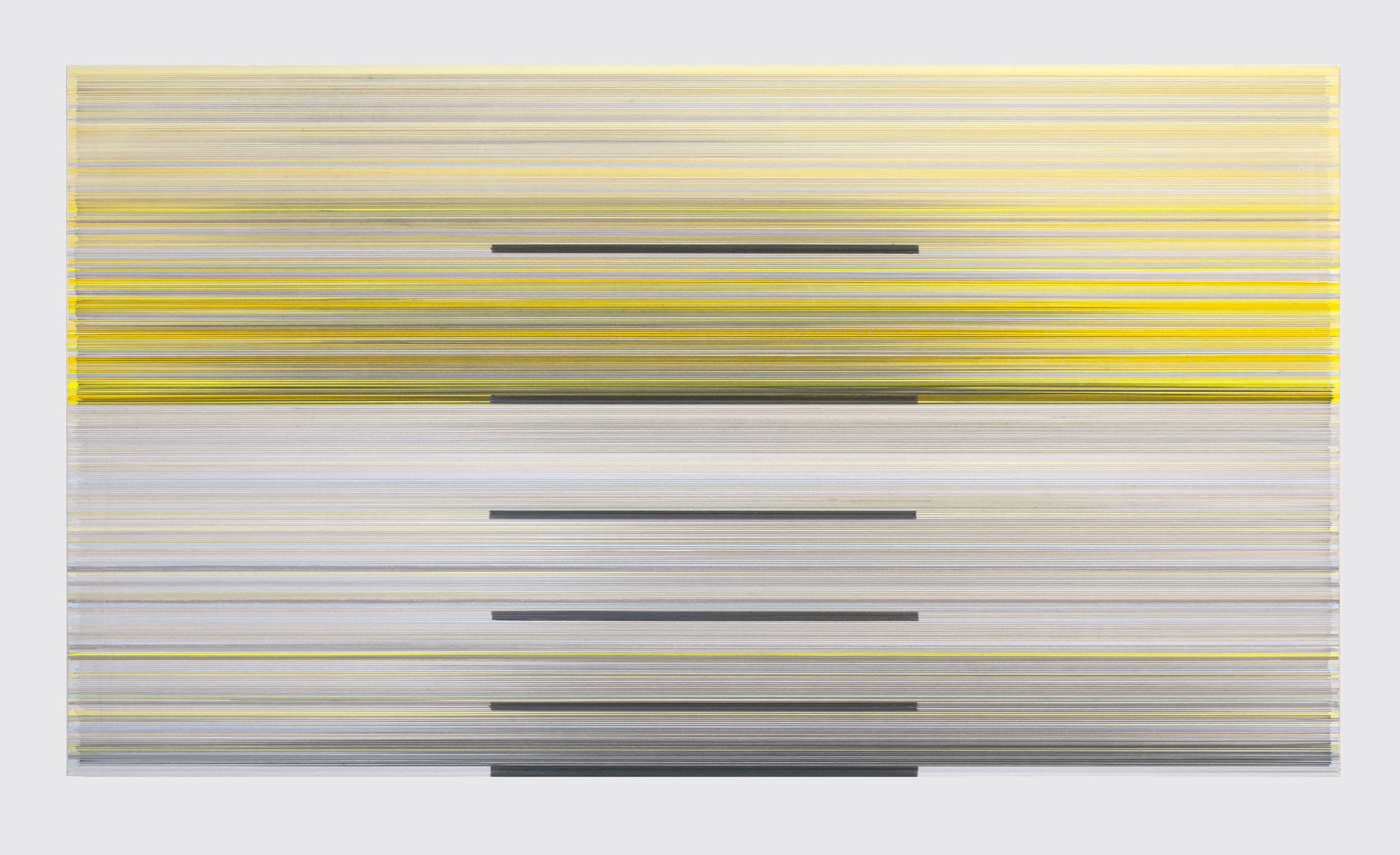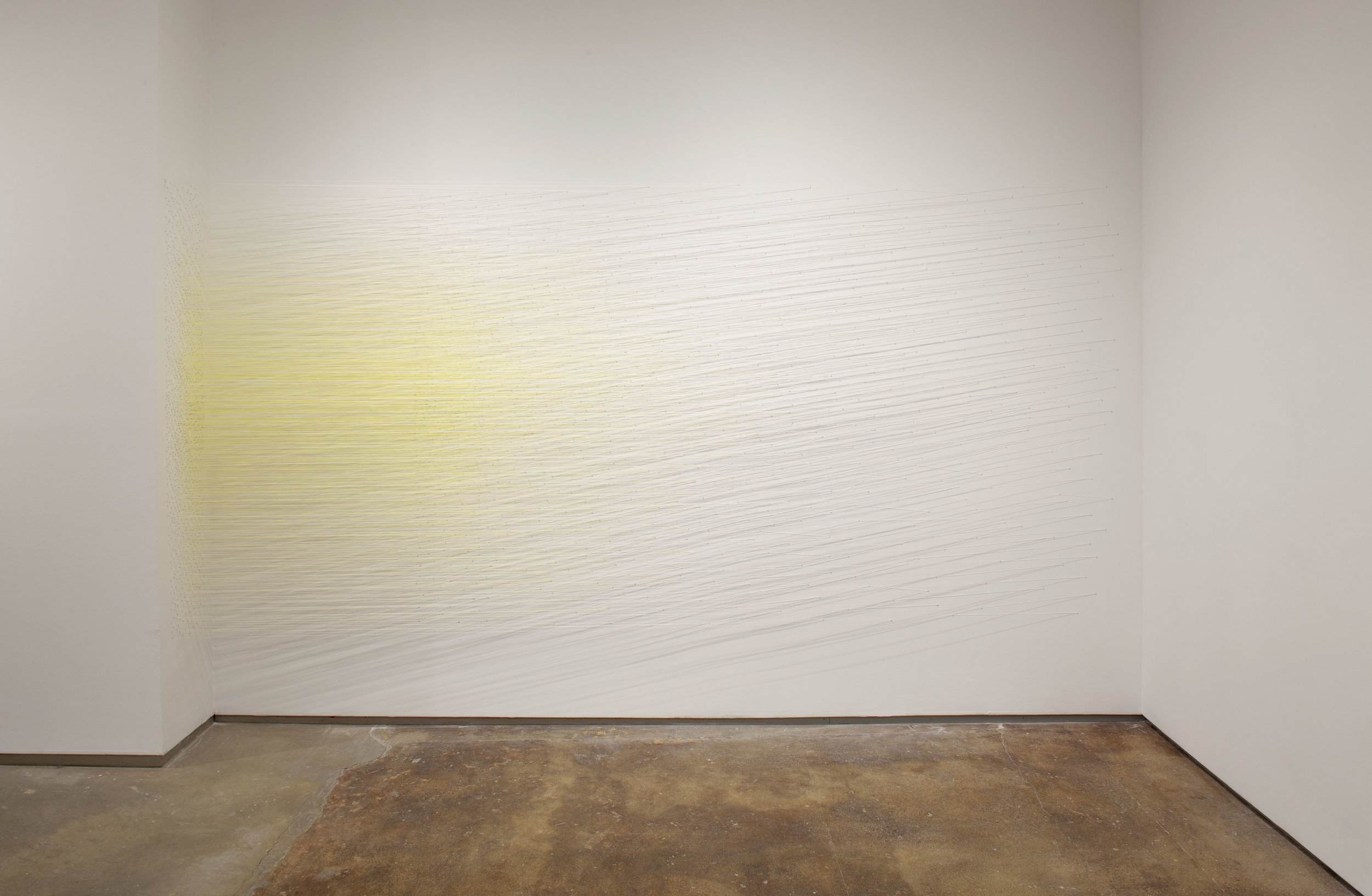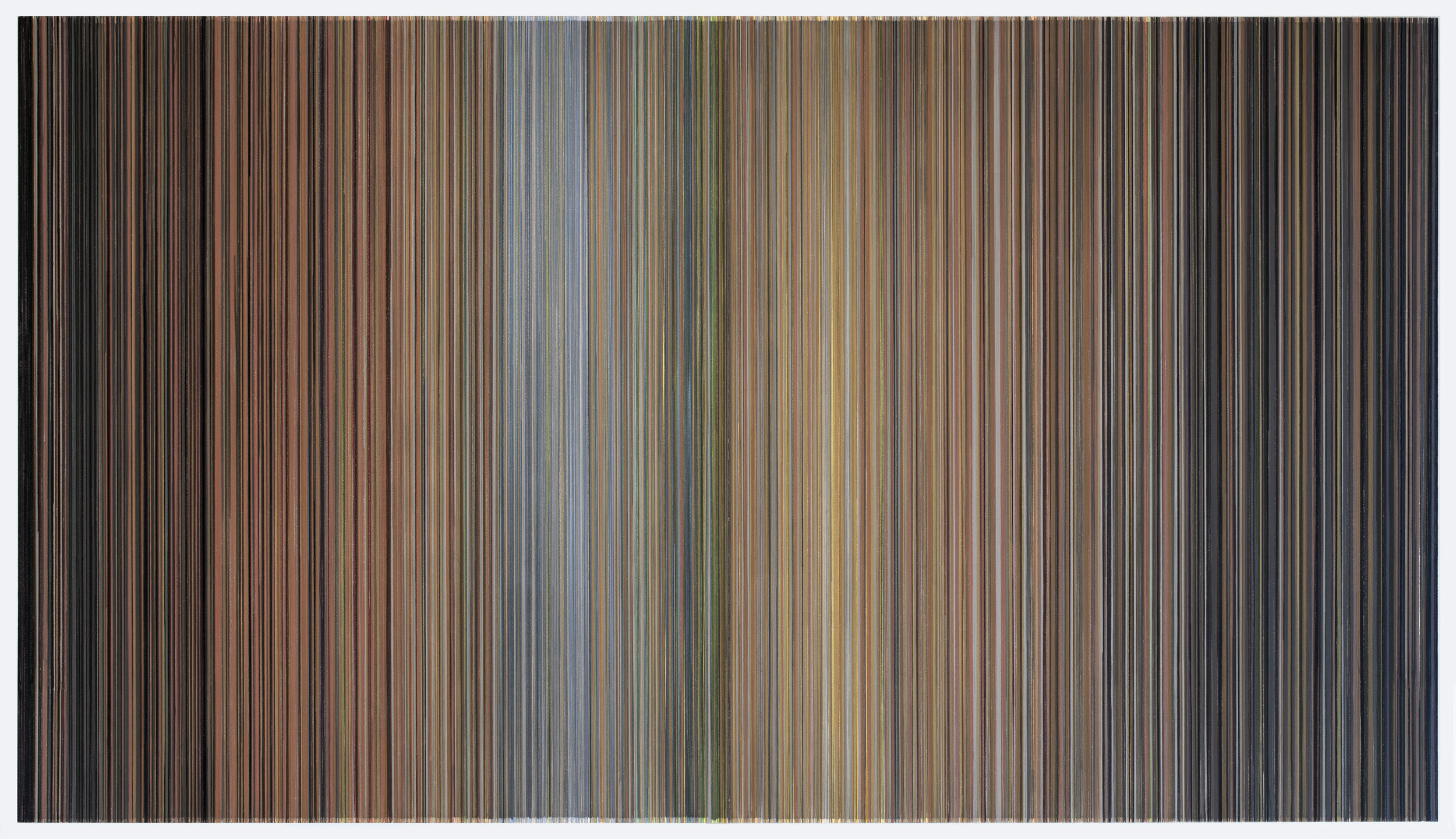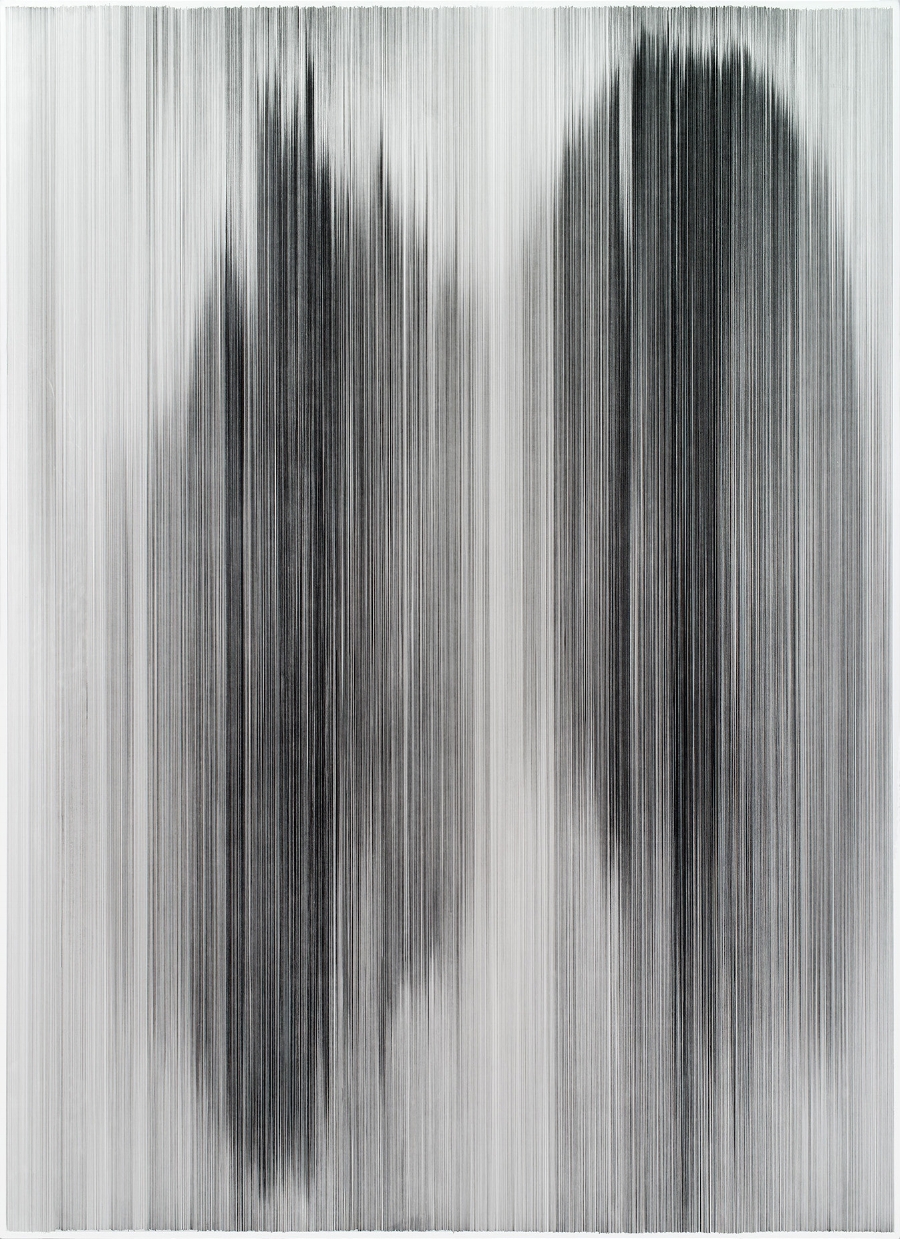Nowhere and Everywhere
SEPTEMBER is pleased to present Nowhere and Everywhere featuring the work of Sarah Braman, Anne Lindberg, and Mary Ellen Strom.
Nowhere and Everywhere* is an exhibition of three major works; Sarah Braman’s glass, steel and wood sculpture, July Dinner, occupies the northeast corner of the gallery, Anne Lindberg’s multi-paneled drawing, I begin with the river, spans the west wall, and Mary Ellen Strom’s photographic installation,TREE LINES, stretches floor to ceiling on the south wall.
Braman’s work, July Dinner, is a rich, chromatic feast. A brightly stained wooden table is suspended between two densely-saturated glass cubes. The table legs hang mid-air, while the table top extends beyond the weighted embrace. The object in its entirety appears to be a singular column of filtered light, magically bisected by a floating table. How do we give form to the unseen? People once ate at this table, prepared meals on it, held conversations around it. And before its domestic life, this table was once a tree fed by light, rooted in the earth. Its story can only be abstractly traced, its specific history unknown. A table out of context is suspended in the image of itself, allowing projections and memories to be set upon it. July Dinner is a moving history, an embodiment of transience. Braman’s material choice of glass is itself an unfixed, amorphous solid. Wood is also in a state of flux, expanding and contracting in response to its surrounding conditions. In fact, the bulk of the work’s composition- color, light, and air- is ephemeral and ever-changing.
Lindberg’s work, I begin with the river, is a sweeping linear expanse of varying gradient and subtle hue. Thousands of graphite lines traced methodically against the edge of a 10ft parallel bar are layered to build tonal shifts. The changing density of mark making offers a spectrum of opacity, from solid to seemingly transparent passages with soft color slipping behind the graphite. The result is a visual plane that appears to be pulsing outwards and inwards, moving left to right. Eluding focal stasis, the expansive scale of this multi-paneled drawing immerses our perception, creating a sensation of floating. Inspired by the Mississippi River, neighbor to Lindberg’s hometown, the work is a reflection of incrementally subtle, but accumulatively major environmental shifts. The Mississippi River itself is flooding, causing havoc, erasing land. Originally intended to be installed at the Figge Art Museum in Davenport, Iowa, half a mile from the Mississippi River, the work now hangs the same distance from the Hudson River, figuratively tracing the geographic path of the artist’s own life transitions. I begin with the river is a poetic embodiment of nature’s only constant: impermanence. The title of the work is drawn from the poem,think like the river, by Lindberg’s collaborator, poet Ginny Threefoot.
Strom’s work, TREE LINES, is a dramatically rising grid of vibrantly colored trees. Hand-painted and photographed from near and distant perspectives, the seven trees are stacked as composited, disjunctured columns. They appear as incomplete versions of themselves, unable to realign or return to a whole form. From three to ten feet tall, each tree embodies a sense of elongated or truncated time, portraits of individuated subjects with varying lifespans. Discovered in Montana where the artist resides, the trees were found dead standing—the end product of a beetle infested forest. The seven colors generate the NTSC video color bar spectrum, suggesting the possibility of being captured in real time and transformed into moving color. An elegiac gesture or ritual of mourning, TREE LINES is an attempt to re-endow life into something that once was living, and to infuse beauty into a place that is suffering an ugly fall.
Nowhere and Everywhere is an exhibition about depicting the unseen and giving form to impermanence—the memory of an orphaned object, the energy of a flooding river, the life of a dying forest. It is about disjuncture and continuity- lines repeated, forms interrupted. It is about the slow, irreversible passage of time, a longing for that which cannot be kept. And it is about beauty and regeneration: here achieved through color, light, movement, and the artist’s empathy for their subject.
*The title of the exhibition is borrowed from Mary Ellen Strom’s body of work by the same name, Nowhere and Everywhere, about La Cienega de Santa Clara, an oasis amidst dried-out mudflats in the Colorado River Delta of Sonora, Mexico. Her title in turn was selected from Aldo Leopold’s 1948 collection of essays, “A Sand County Almanac” about the Colorado River Delta.
SARAH BRAMAN
Sarah Braman (b. 1970) received a BFA from Maryland Institute College of Art in Baltimore and an MFA from Tyler School of Art in Philadelphia. Solo exhibitions include True Blue Mirror, with Ellen Berkenblit, McEvoy Foundation for the Arts (San Francisco, CA), Growth, Mitchell-Innes & Nash (NYC), Here, Marlborough Contemporary (London), You Are Everything, Mitchell-Innes & Nash (NYC), Sarah Braman: Alive, Museum of Fine Arts (Boston, MA) and Lay Me Down, MACRO (Rome). Braman has also participated in group exhibitions at Crystal Bridges (Bentonville, AR), MASS MoCA (North Adams, MA), the Brant Foundation (Greenwich, CT), Kunsthalle (Helsinki, Finland), The Kemper Museum of Contemporary Art (Kansas City, MO), The Saatchi Gallery (London), among others. Braman is one of the founders of artist-run gallery CANADA in New York. In 2013, she was the recipient of the Maud Morgan Prize from MFA, Boston. She currently lives and works between New York and Amherst, Massachusetts.
ANNE LINDBERG
Anne Lindberg (b. 1962) received her BFA from Miami University in 1985 and an MFA from Cranbrook Academy of Art in 1988. Her work has been in solo and group exhibitions at such places as The Drawing Center (NYC), Tegnerforbundet (Norway), SESC Bom Retiro (Sao Paulo), Nerman Museum of Contemporary Art (Overland Park, KS), Detroit Institute of Art, Bemis Center for Contemporary Art (Omaha, NE), Cranbrook Art Museum (Detroit, MI), Nevada Museum of Art, Spencer Museum of Art (Lawrence, KS), and Kemper Museum of Contemporary Art (Kansas City, MO), the Museum of Arts and Design (NYC), Thomas Cole Historic Site (Catskill, NY), Contemporary Art Museum Raleigh, Akron Art Museum, Josee Bienvenu Gallery (NYC), Schick Art Gallery at Skidmore College, September Gallery (Hudson, NY), Omi International Art Center (Ghent, NY), the John Michael Kohler Arts Center (Kohler, WI), and the Figge Art Museum (Davenport, IA) among others. She is the recipient of awards including a 2011 Painters & Sculptors Joan Mitchell Foundation Grant, a Charlotte Street Foundation Fellowship, two ArtsKC Fund Inspiration Grants, a Lighton International Artists Exchange grant, the Art Omi International Artists Residency, an American Institute of Architects Allied Arts and Crafts award, and a Mid-America National Endowment for the Arts Fellowship. She works in Ancramdale, New York.
MARY ELLEN STROM
Mary Ellen Strom (b. 1970) received her MFA from the University of California, Irvine and is an instructor at the School of the Museum of Fine Arts, Boston. Strom’s work has been presented at the Museum of Contemporary Art (Los Angeles, CA), the Museum of Modern Art (NYC), The Wexner Center for the Arts (Columbus, OH), The Chicago Art Institute (Chicago, IL), The Walker Art Center (Minneapolis, MN), Kansas City Art Institute (Kansas City, MO), The High Museum (Atlanta, GA), Diverseworks (Houston, TX), Archa, Theatro Divaldo (Prague, CZ), Museo de Arte (Mexico City, MX), Temple Bar (Dublin, IRL), Ars Electronica Festival (Linz, AU), Chapter Art Centre (Cardiff, WAL), among others. Strom has received awards including the Rockefeller Foundation, M.A.P. Grants, New York State Council on the Arts, National Endowment for the Arts, National Alliance for Media and Culture, and two New York Performance Awards (Bessie) for “Outstanding Creative Achievement”. Strom was a 1999-2000 artist in the P.S.1 / MoMA National Studio Program. She currently lives and works in Amherst, Massachusetts.
Image: Mary Ellen Strom, TREE LINES (detail), 2013, digital print, 20 x 30 inches
For further information please visit the gallery at 449 Warren Street, Hudson, NY, visit our website at septembergallery.com, or contact Kristen Dodge at kristen@septembergallery.com.




